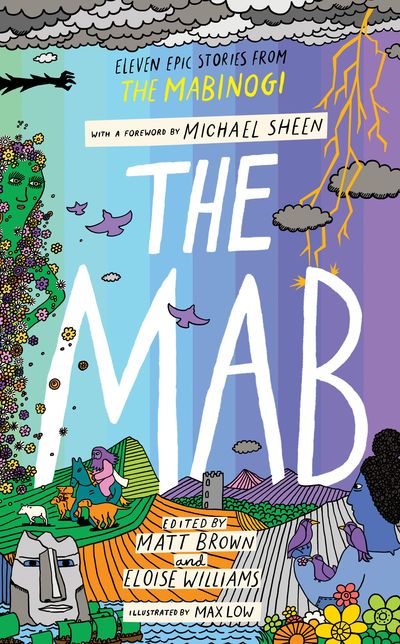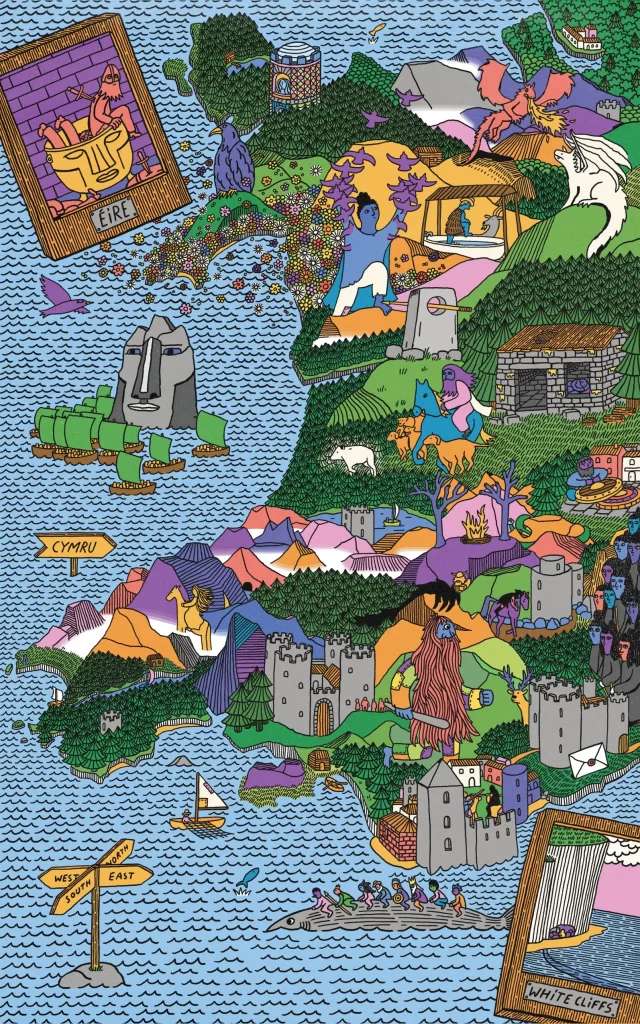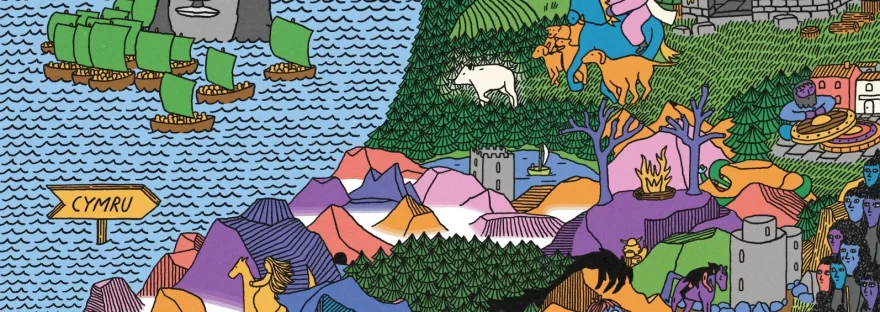Edited by Matt Brown & Eloise Williams, illustrated by Max Low (published by Unbound, 2022)
But as well as being really, really old, the stories in The Mab are thrilling and funny and MAGIC. They speak of a time when the gates between the Real World and the Otherworld were occasionally left open. And sometimes, just sometimes, it was possible to step through. Trust me, you’re going to love them.
So states the introduction to The Mab, a gathering and retelling of eleven tales from the classic Welsh folklore collection The Mabinogi or Mabinogion – and it isn’t wrong.
For those not familiar with it, the original stories are believed to be the earliest written prose in Britain, dating to the 12th-13th centuries (though the tales themselves may be older). Their genres vary widely from story to story, covering classical historical and hero tales full of romance and tragedy, to marvellous flights of humour and fantasy. Some of them also feature the familiar figure of King Arthur and his knights, though pre-dating the classical romance character that we might recognise today.
It’s safe to say then that The Mabinogi (or Mabinogion depending which version you read) is an important collection from a historical and literary point of view; but it’s also true that the prose and the stories themselves are quite complex. Many of them contain asides or multiple parts outside of what might be considered the “main” storyline, and the cast of characters is long, with some reappearing in minor roles later on. The world that the stories portray is rich and intricate, but not necessarily the most accessible – especially to younger readers.

This is where The Mab comes in. Every individual story is retold by a different author, each with a unique voice and approach, and all intended for younger or less confident readers who want a chance to experience Welsh folklore.
At this point I have to confess that I haven’t read the original collection of tales (although it is on my list), which means that my review is coming from a blank slate with regards to the adaptations. I will say however that my partner, a voracious reader, has commented about the originals being a bit heavy-going, so I feel that stating The Mab is more accessible is a valid point.
The first thing that you see is of course the front cover, which utilises images from the inside of the book, weaved together in a striking tapestry. Max Low’s art immediately gives you a sense of magic and wonder, from the bold lines of the fields to the bright colours of the flowers and sky.
Each story gets its own full-page illustration at the start, again in these vibrant hues. They’re not the type of images most of us would automatically associate with folklore, being so bright and relatively simplistic in their style. But they are perfect for bringing to life a new, modern (in design, not in content) approach to the stories.

Just like more traditional versions of the book, The Mab features a map in the front of the relevant locations – for someone who doesn’t know Wales very well, this is a very handy feature. And, as regular readers here will know, I’m a sucker for a map! (Seriously, just look at it!)
I don’t plan to summarise the stories here, as each is short and so different from the others that it could be considered to be completely stand-alone. But each author has done a great job of introducing the characters and the themes in a realistic and understandable way, using modern phrasing and idioms where appropriate that will likely help younger readers feel more comfortable.
Knowing that each author has a connection with Wales gives you a sense of authenticity, and a feeling that they really care not just about the stories themselves, but about getting them out in front of a new audience. (I have provided a full list of the stories and their respective authors at the end of the post.)
The stories themselves have been pruned – they’ve needed to be, considering how long the originals were. Some of the characters benefit from being viewed through a more modern lens, and a narrator who is perhaps a bit more sympathetic to their woes than the originals were. Although some of the tales are still a little grim or gruesome, the way they are couched means they do not feel too adult to be included.
The stories themselves range from charming to more desolate; some characters get their comeuppances, while others suffer needlessly. Some tales come to satisfying conclusions, while others leave you wondering what happened afterwards. Together, they all paint a deep and engaging image of a Wales of the past, its landscape, beliefs and people, that makes you want to read more.
As well as the tales, we are treated to a charming foreword by none other than actor Michael Sheen, who has been a supporter of the project since its onset. And perhaps more importantly (apologies Mr Sheen!), each story is written in both English and Welsh. Popular Welsh author Bethan Gwanas was on translation duty for the book, and it is just so wonderful to see the Welsh tales also being written specifically for younger Welsh readers.
Finally, at the back of the book, there is a handy pronunciation guide, going over some of the general linguistic rules for Welsh, and lists divided up by story so that you can understand how the different character and place names are said. As someone fascinated by language, I definitely found myself keeping a finger in that page and practicing them out loud as they came up!
It’s worth remembering that it is not just the authors and translator, nor even Mr Sheen, that made this book happen – editors Matt Brown and Eloise Williams deserve a big hand, for bringing everything together and ensuring the project succeeded.
Yes, there will possibly be purists upset that the tales have undergone any form of “modernisation”, but the truth is that the original stories are simply not ideal reading for most children. The Mab gives older readers like myself the chance to familiarise ourselves with the tales before diving into the deep end. And it gives younger readers the chance to enjoy and become immersed in the folklore without being hampered or dragged down by the complex narratives and old-fashioned language.
And then perhaps, when they’re older, they’ll go ahead and read the originals, and be able to enjoy them too for the works of linguistic and historical art that they are. But I guarantee they’ll keep coming back to The Mab – I know I will.
Stories in The Mab
Rhiannon, Pwyll and the Hideous Claw – Matt Brown
Branwen and the Cauldron of Rebirth – Sophie Anderson
Happily Ever After – Nicola Davies
Meadowsweet and Magic – Eloise Williams
Peredur, the Monster and the Serpent of the Cairn – Darren Chetty
Follow the Dream – Alex Wharton
Three Graces – Zillah Bethell
Luned and the Magic Ring – Rhian Ivory
Geraint, Enid and the Big Knight Fight – P.G. Bell
The Amazing Eight – Hanan Issa
The Strange and Spectacular Dream of Rhonabwy the Restless – Claire Fayers
If you’re raring to read The Mab, you can grab a copy at the link below.
(Disclosure: If you buy books linked to our site, we may earn a commission from Bookshop.org, whose fees support independent bookshops.)
Looking for more folklore tales to enjoy? If so, you can check out some of our previous folktale reviews here.

